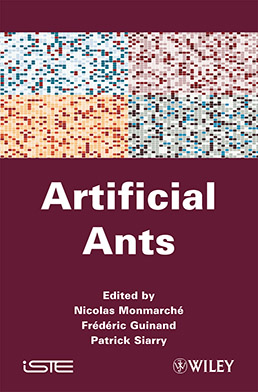
Artificial ants take their inspiration from observations in nature: animal societies, such as ant colonies, have developed collective behaviors with fascinating efficiency and robustness. The motivation to imitate nature has grown increasingly, and throughout the last decade, artificial ants have experienced rapid development in the research community, mainly for solving optimization problems. Now these algorithms have proved their efficiency and are widely used in the industrial world. The purpose of this book is to provide an overview of the current situation of ant colony algorithms. Part 1 helps to understand the basis of ant colony algorithms, and to discover a panorama of applications in the field of optimization, particularly in the industrial world. Part 2 deals with broader issues, i.e. those not limited to optimization, and provides an overview of current research in the field of artificial ants.
1. From Real Ants to Artificial Ants, A. Lenoir and N. Monmarché.
2. General Principles of Combinatorial Problems Solving by Ant Colony, A. Dutot et al.
3. General Survey of Combinatorial Problems Treated by Artificial Ants, A. Dutot and Y. Pigné.
4. Artificial Ants for Continuous Optimization, P. Siarry et al.
5. Ant Colony Optimization for Constraint-based Configuration, P. Albert, L. Henocque and M. Kleiner.
6. Ant Colonies for the Unit Commitment Problem: From Optimization to Predictive Control, G. Sandou et al.
7. Ant Colony Optimization for Manufacturing Aluminum Bars, M. Gravel and C. Gagné.
8. Ant Colony Optimization for Car Sequencing, C. Gagné and M. Gravel.
9. An Ant Algorithm for Measuring and Optimizing the Capacity of a Railway Infrastructure, X. Gandibleux et al.
10. Artificial Ants for MRI Segmentation, A. Nakib et al.
11. Vertex Coloring Using Ant Colonies, A. Hertz and N. Zufferey.
12. Training of Hidden Markov Models Using API Ant Algorithm, S. Aupetit, N. Monmarché and M. Slimane.
13. Artificial Ants for Automatic Classification, A. Hamdi et al.
14. Collective and Mobile Robotics Inspired by Insects, P. Urbano, N. Monmarché and P. Gaucher.
15. Artificial Insects: Design and Achievement of a Popular Science Exhibition Aimed to Promote Collective Artificial Intelligence and Bio-inspired Robotics, N. Monmarché et al.
16. Ant Colony Optimization for Routing in Mobile Networks in Urban Environment, G. A. Di Caro, F. J. A. Ducatelle and L. M. Gambardella.
17. Detection of Organizations in Complex Systems Using Ant Colonies, A. Dutot and D. Oliver.
18. Artificial Ants and Disability: Three Examples Dealing with the Compensation for Autonomy Losses and Games for Visually Impaired People, A. Sepchat et al.
19. Artificial Ants for Artificial Art, N. Monmarché and R. Clair.
20. Artificial Ants for Natural Language Processing, F. Guinand and M. Lafourcade.
21. Artificial Ants and Bioinformatics (Protein Folding, Multiple Alignement and Sequencing by Hybridization), S. Balev, O. Gaci and Y. Pigné.
Nicolas Monmarché is Assistant Professor in computer science. His main research interests are collective intelligence and swarm behaviors based on ants for solving computer science problems.
Frédéric Guinand is Professor in informatics. His main research interests are mobile ad hoc networks, dynamic graphs and complex systems, bio-inspired methods and scheduling for distributed and parallel systems.
Patrick Siarry is Professor in automatics. His main research interests are stochastic hard optimization heuristics and their use for solving continuous optimization problems.